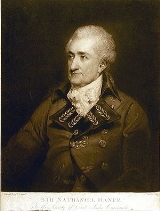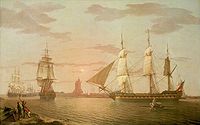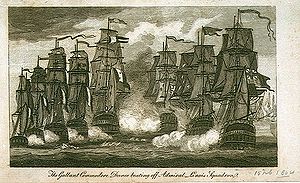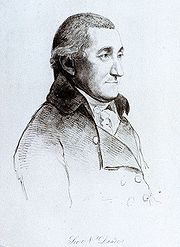
Nathaniel Dance
Encyclopedia
Sir Nathaniel Dance was an officer of the Honourable East India Company who had a long and varied career on merchant vessels, making numerous voyages to India
and back with the fleets of East Indiamen
. He was already aware of the risks of the valuable ships he sailed on being preyed on by foreign navies, having been captured by a Franco-Spanish
fleet in 1780 during the East Indies campaign of the American War of Independence. His greatest achievement came during the Napoleonic Wars
, when having been appointed commodore
of one of the company's fleets, he came across a French squadron under Rear-Admiral Comte de Linois
, which was raiding British shipping in the area. Through skilful seamanship and aggressive tactics he fooled the French commander into thinking that the British convoy was escorted by powerful naval forces, and the French decided not to risk attacking the convoy. Dance compounded the deception by taking his lightly armed merchants and chasing the French away, despite the considerable disparity of force. Having saved the convoy from almost certain destruction, Dance was hailed as a hero, lavishly rewarded with money and a knighthood, and spent the last years of his life in comfortable retirement.
on 20 June 1748, the son of James Dance and his wife Elizabeth. James Dance was a successful lawyer of the city, but shortly after the birth of Nathaniel, he abandoned his wife to live with an actress, and in time established himself as a successful actor and playwright in Drury Lane
. Elizabeth Dance and her family were instead cared for by James's father, and Nathaniel's paternal grandfather, George Dance the Elder
, a prominent architect for the City of London. Nathaniel lived with his grandfather until 1759, when he went to sea under the patronage of Nathaniel Smith, a high-ranking official in the Honourable East India Company. With Smith's support, Dance rose through the ranks of the service, having made made eight voyages to India, as well as one to the Mediterranean and one to the West Indies by 1780. While making his ninth voyage to India he and his ship were captured by a combined French and Spanish fleet. Dance was taken to Spain, where he spent six months on parole. He became commander of the Lord Camden in January 1787, making another four voyages to India aboard her, before being appointed commander of a new ship, the Earl Camden, in which he sailed to China in January 1803.
 The Earl Camden sailed from Canton
The Earl Camden sailed from Canton
with the rest of the fleet on 31 January 1804, bound for England. By virtue of his seniority Dance was appointed commodore of the fleet of 11 "country" ships, and 16 East Indiamen. The fleet that had been assembled was the richest to date, carrying cargoes with an estimated value of £8 million, (approximately £ in present day terms). Dance had been taken seriously ill at Bombay during the outward voyage, but had recovered in time to sail with the convoy. The fleet did not have any naval escorts, and though the East Indiamen were heavily armed for merchants, carrying nominal batteries of between 30 and 36 guns, they were no match for disciplined and professional naval forces. Not all of their listed armament was always carried, but to give the illusion of greater strength, fake gunports were often painted on the hulls, in the hope of distant observers mistaking them for 64-gun ships of the Royal Navy
. By the time the fleet approached the Strait of Malacca
on 14 February, Dance's convoy had swelled to include 16 East Indiamen, 11 country ships, a Portuguese merchant ship from Macau
and a vessel from Botany Bay
in Australia
. Although the HEIC had provided the small, armed brig Ganges as an escort, this vessel could only dissuade pirates; it could not hope to compete with a French warship. As they neared the entrance to the straits suspicious sails were sighted in the south west. Dance sent some of his ships to investigate, and it was soon discovered that this was Linois's squadron, consisting of the 74-gun Marengo
, the two heavy frigate
s Sémillante
and Belle Poule
, the corvette
Berceau
, and the Dutch brig
Aventurier.
 Having ascertained the identity of the ships Dance signalled for his merchants to form the line of battle, and continued their heading, while the French closed, but made no move to attack. Dance used the delay to gather his ships together so the stronger East Indiamen stood between the French and the weaker country ships. The merchants continued on towards the straits, followed by Linois, who was trying to gauge the strength of the convoy. There were more ships in the convoy than he had expected, and taken in by Dance's manoeuvres and the painted gunports, Linois suspected that several warships were escorting them. He seemed to be confirmed in his suspicions when at dawn on 15 February, both forces raised their colours. Dance ordered the brig Ganges and the four lead ships to hoist blue ensigns
Having ascertained the identity of the ships Dance signalled for his merchants to form the line of battle, and continued their heading, while the French closed, but made no move to attack. Dance used the delay to gather his ships together so the stronger East Indiamen stood between the French and the weaker country ships. The merchants continued on towards the straits, followed by Linois, who was trying to gauge the strength of the convoy. There were more ships in the convoy than he had expected, and taken in by Dance's manoeuvres and the painted gunports, Linois suspected that several warships were escorting them. He seemed to be confirmed in his suspicions when at dawn on 15 February, both forces raised their colours. Dance ordered the brig Ganges and the four lead ships to hoist blue ensigns
, while the rest of the convoy raised red ensigns
. By the system of national flags then in use in British ships, this implied that the ships with blue ensigns were warships attached to the squadron of Admiral Peter Rainier
, while the others were merchant ships under their protection.
With the French still appearing reluctant to attack on the morning of 16 February, Dance ordered his ships to increase their speed by breaking into a sailing formation. This had the effect of making the convoy appear less intimidating and Linois decided to attack. By the afternoon the French were observed to be moving to cut off the rearmost ships of the convoy. Dance promptly hoisted colours, and ordered his largest ships, led by the East Indiamen Royal George, Ganges and his own ship, Earl Camden, to come about and close on the French. Advancing under full sail, they endured the fire of the French as they closed, before firing broadsides at close range. At this the French abandoned their attack, turned, and fled under a press of sail. Dance hoisted the signal for a general chase and his merchant fleet pursued the French squadron for two hours, before Dance broke off and returned on his original heading. The fleet resumed their course towards the Malacca Strait, and having met two British ships of the line from Admiral Peter Rainier's fleet on 28 February, were escorted as far as Saint Helena
. There the convoy met with other British merchants, and were escorted to Britain by Royal Navy warships, arriving in August 1804.
 The Naval Chronicle declared:
The Naval Chronicle declared:
Dance himself credited the actions of those under his command as being largely responsible for the victory, writing in reply to the award from the Bombay Insurance Company:
Dance received a knighthood and went into a comfortable retirement, dying at Enfield
on 25 March 1827 at the age of 78.
India
India , officially the Republic of India , is a country in South Asia. It is the seventh-largest country by geographical area, the second-most populous country with over 1.2 billion people, and the most populous democracy in the world...
and back with the fleets of East Indiamen
East Indiamen
An East Indiaman was a ship operating under charter or license to any of the East India Companies of the major European trading powers of the 17th through the 19th centuries...
. He was already aware of the risks of the valuable ships he sailed on being preyed on by foreign navies, having been captured by a Franco-Spanish
Action of 9 August 1780
The Action of 9 August 1780 was a naval engagement of the American Revolutionary War in which the main Spanish fleet led by Admiral Luis de Córdova y Córdova, together with a squadron of French ships, captured a heavy British convoy of sixty-three vessels causing a severe blow to the commerce of...
fleet in 1780 during the East Indies campaign of the American War of Independence. His greatest achievement came during the Napoleonic Wars
Napoleonic Wars
The Napoleonic Wars were a series of wars declared against Napoleon's French Empire by opposing coalitions that ran from 1803 to 1815. As a continuation of the wars sparked by the French Revolution of 1789, they revolutionised European armies and played out on an unprecedented scale, mainly due to...
, when having been appointed commodore
Commodore (rank)
Commodore is a military rank used in many navies that is superior to a navy captain, but below a rear admiral. Non-English-speaking nations often use the rank of flotilla admiral or counter admiral as an equivalent .It is often regarded as a one-star rank with a NATO code of OF-6, but is not always...
of one of the company's fleets, he came across a French squadron under Rear-Admiral Comte de Linois
Charles-Alexandre Léon Durand Linois
Charles-Alexandre Léon Durand, Comte de Linois was a French admiral during the time of Napoleon Bonaparte. He won a victory over the British at the Battle of Algeciras in 1801 and was reasonably successful in a campaign against British trade in the Indian Ocean and South China Sea in...
, which was raiding British shipping in the area. Through skilful seamanship and aggressive tactics he fooled the French commander into thinking that the British convoy was escorted by powerful naval forces, and the French decided not to risk attacking the convoy. Dance compounded the deception by taking his lightly armed merchants and chasing the French away, despite the considerable disparity of force. Having saved the convoy from almost certain destruction, Dance was hailed as a hero, lavishly rewarded with money and a knighthood, and spent the last years of his life in comfortable retirement.
Family and early life
Dance was born in LondonLondon
London is the capital city of :England and the :United Kingdom, the largest metropolitan area in the United Kingdom, and the largest urban zone in the European Union by most measures. Located on the River Thames, London has been a major settlement for two millennia, its history going back to its...
on 20 June 1748, the son of James Dance and his wife Elizabeth. James Dance was a successful lawyer of the city, but shortly after the birth of Nathaniel, he abandoned his wife to live with an actress, and in time established himself as a successful actor and playwright in Drury Lane
Drury Lane
Drury Lane is a street on the eastern boundary of the Covent Garden area of London, running between Aldwych and High Holborn. The northern part is in the borough of Camden and the southern part in the City of Westminster....
. Elizabeth Dance and her family were instead cared for by James's father, and Nathaniel's paternal grandfather, George Dance the Elder
George Dance the Elder
George Dance the Elder was an English architect of the 18th century. He served as the City of London surveyor and architect from 1735 until his death....
, a prominent architect for the City of London. Nathaniel lived with his grandfather until 1759, when he went to sea under the patronage of Nathaniel Smith, a high-ranking official in the Honourable East India Company. With Smith's support, Dance rose through the ranks of the service, having made made eight voyages to India, as well as one to the Mediterranean and one to the West Indies by 1780. While making his ninth voyage to India he and his ship were captured by a combined French and Spanish fleet. Dance was taken to Spain, where he spent six months on parole. He became commander of the Lord Camden in January 1787, making another four voyages to India aboard her, before being appointed commander of a new ship, the Earl Camden, in which he sailed to China in January 1803.
Voyage home

Guangzhou
Guangzhou , known historically as Canton or Kwangchow, is the capital and largest city of the Guangdong province in the People's Republic of China. Located in southern China on the Pearl River, about north-northwest of Hong Kong, Guangzhou is a key national transportation hub and trading port...
with the rest of the fleet on 31 January 1804, bound for England. By virtue of his seniority Dance was appointed commodore of the fleet of 11 "country" ships, and 16 East Indiamen. The fleet that had been assembled was the richest to date, carrying cargoes with an estimated value of £8 million, (approximately £ in present day terms). Dance had been taken seriously ill at Bombay during the outward voyage, but had recovered in time to sail with the convoy. The fleet did not have any naval escorts, and though the East Indiamen were heavily armed for merchants, carrying nominal batteries of between 30 and 36 guns, they were no match for disciplined and professional naval forces. Not all of their listed armament was always carried, but to give the illusion of greater strength, fake gunports were often painted on the hulls, in the hope of distant observers mistaking them for 64-gun ships of the Royal Navy
Royal Navy
The Royal Navy is the naval warfare service branch of the British Armed Forces. Founded in the 16th century, it is the oldest service branch and is known as the Senior Service...
. By the time the fleet approached the Strait of Malacca
Strait of Malacca
The Strait of Malacca is a narrow, stretch of water between the Malay Peninsula and the Indonesian island of Sumatra. It is named after the Malacca Sultanate that ruled over the archipelago between 1414 to 1511.-Extent:...
on 14 February, Dance's convoy had swelled to include 16 East Indiamen, 11 country ships, a Portuguese merchant ship from Macau
Macau
Macau , also spelled Macao , is, along with Hong Kong, one of the two special administrative regions of the People's Republic of China...
and a vessel from Botany Bay
Botany Bay
Botany Bay is a bay in Sydney, New South Wales, a few kilometres south of the Sydney central business district. The Cooks River and the Georges River are the two major tributaries that flow into the bay...
in Australia
Australia
Australia , officially the Commonwealth of Australia, is a country in the Southern Hemisphere comprising the mainland of the Australian continent, the island of Tasmania, and numerous smaller islands in the Indian and Pacific Oceans. It is the world's sixth-largest country by total area...
. Although the HEIC had provided the small, armed brig Ganges as an escort, this vessel could only dissuade pirates; it could not hope to compete with a French warship. As they neared the entrance to the straits suspicious sails were sighted in the south west. Dance sent some of his ships to investigate, and it was soon discovered that this was Linois's squadron, consisting of the 74-gun Marengo
French ship Jean-Jacques Rousseau (1795)
The Jean-Jacques Rousseau was a Téméraire class 74-gun ship of the line of the French Navy.In October 1796, under captain Racord, she was part of the Villeneuve's squadron that sailed from Toulon to Brest...
, the two heavy frigate
Frigate
A frigate is any of several types of warship, the term having been used for ships of various sizes and roles over the last few centuries.In the 17th century, the term was used for any warship built for speed and maneuverability, the description often used being "frigate-built"...
s Sémillante
French frigate Sémillante (1792)
The Sémillante was a 32-gun frigate of the French Navy, lead ship of her class. She was involved in a number of multi-vessel actions against the Royal Navy, particularly in the Indian Ocean. She captured a number of East Indiamen before the she became so damaged that the French disarmed her and...
and Belle Poule
HMS Belle Poule (1806)
HMS Belle Poule was a 40-gun Royal Navy fifth rate frigate, formerly Belle Poule, a Virginie-class frigate of the French Navy, which was built by the Crucy family's shipyard at Basse-Indre to a design by Jacques-Noël Sané...
, the corvette
Corvette
A corvette is a small, maneuverable, lightly armed warship, originally smaller than a frigate and larger than a coastal patrol craft or fast attack craft , although many recent designs resemble frigates in size and role...
Berceau
French corvette Berceau (1794)
The Berceau was a 22-gun corvette of the French Navy.In 1799, she took part in the Cruise of Bruix. On 11 May, Admiral Bruix set his flag on Berceau to direct a battle against the British off Cadiz; after the Spanish broke contact, Bruix cancelled the attack.On 13 July 1800, Berceau measured...
, and the Dutch brig
Brig
A brig is a sailing vessel with two square-rigged masts. During the Age of Sail, brigs were seen as fast and manoeuvrable and were used as both naval warships and merchant vessels. They were especially popular in the 18th and early 19th centuries...
Aventurier.
The battle

Blue Ensign
The Blue Ensign is a flag, one of several British ensigns, used by certain organisations or territories associated with the United Kingdom. It is used either plain, or defaced with a badge or other emblem....
, while the rest of the convoy raised red ensigns
Red Ensign
The Red Ensign or "Red Duster" is a flag that originated in the early 17th century as a British ensign flown by the Royal Navy and later specifically by British merchantmen. The precise date of its first appearance is not known, but surviving receipts indicate that the Navy was paying to have such...
. By the system of national flags then in use in British ships, this implied that the ships with blue ensigns were warships attached to the squadron of Admiral Peter Rainier
Peter Rainier, junior
Peter Rainier, Jr. was a British naval officer. Mount Rainier in Washington, USA, was named after him.-Biography:Rainier was born in England, the grandson of Daniel Regnier, a Huguenot refugee, and the son of Peter Rainier of Sandwich. He enlisted in the Royal Navy in 1756 at the age of 15. He...
, while the others were merchant ships under their protection.
With the French still appearing reluctant to attack on the morning of 16 February, Dance ordered his ships to increase their speed by breaking into a sailing formation. This had the effect of making the convoy appear less intimidating and Linois decided to attack. By the afternoon the French were observed to be moving to cut off the rearmost ships of the convoy. Dance promptly hoisted colours, and ordered his largest ships, led by the East Indiamen Royal George, Ganges and his own ship, Earl Camden, to come about and close on the French. Advancing under full sail, they endured the fire of the French as they closed, before firing broadsides at close range. At this the French abandoned their attack, turned, and fled under a press of sail. Dance hoisted the signal for a general chase and his merchant fleet pursued the French squadron for two hours, before Dance broke off and returned on his original heading. The fleet resumed their course towards the Malacca Strait, and having met two British ships of the line from Admiral Peter Rainier's fleet on 28 February, were escorted as far as Saint Helena
Saint Helena
Saint Helena , named after St Helena of Constantinople, is an island of volcanic origin in the South Atlantic Ocean. It is part of the British overseas territory of Saint Helena, Ascension and Tristan da Cunha which also includes Ascension Island and the islands of Tristan da Cunha...
. There the convoy met with other British merchants, and were escorted to Britain by Royal Navy warships, arriving in August 1804.
Rewards
The achievement of a convoy of merchants not only escaping without loss from a French squadron, but going so far as to attack, drive off, and then pursue their would-be predators, was widely hailed as a signal victory.
We cannot sufficiently express our opinion of the coolness, intrepidity, and skill, with which the Commander of this Fleet, unaccustomed as he was to the practice of naval engagements, provided against every emergency, and prepared his plans, either for attack or defence, as the manoeuvres of the French Admiral might render it expedient for him to adopt either the one of the other. His conduct was worthy of the experience and science of our most approved and veteran Admirals, while the ardour and promptitude with which his orders were obeyed and his plans executed by the several Captains under his command, may have been rivalled, but can scarcely be exceeded in the most renowned of our naval exploits.Dance received £5,000 from the Bombay Insurance Company (approximately £338,000 in present day terms), a pension of £500 a year (approximately £34,000 a year in present day terms), plate worth 200 guineas from the Honourable East India Company, a ceremonial sword worth £100, and a silver vase. His captains were also rewarded. Captain Timmins of the Royal George received £1000, a sword and plate, while the other captains received £500, and a sword and plate, with money being paid to the officers and seaman under their command, with an ordinary seaman receiving £6 (approximately £ in present day terms).
Dance himself credited the actions of those under his command as being largely responsible for the victory, writing in reply to the award from the Bombay Insurance Company:
Dance received a knighthood and went into a comfortable retirement, dying at Enfield
London Borough of Enfield
The London Borough of Enfield is the most northerly London borough and forms part of Outer London. It borders the London Boroughs of Barnet, Haringey and Waltham Forest...
on 25 March 1827 at the age of 78.

